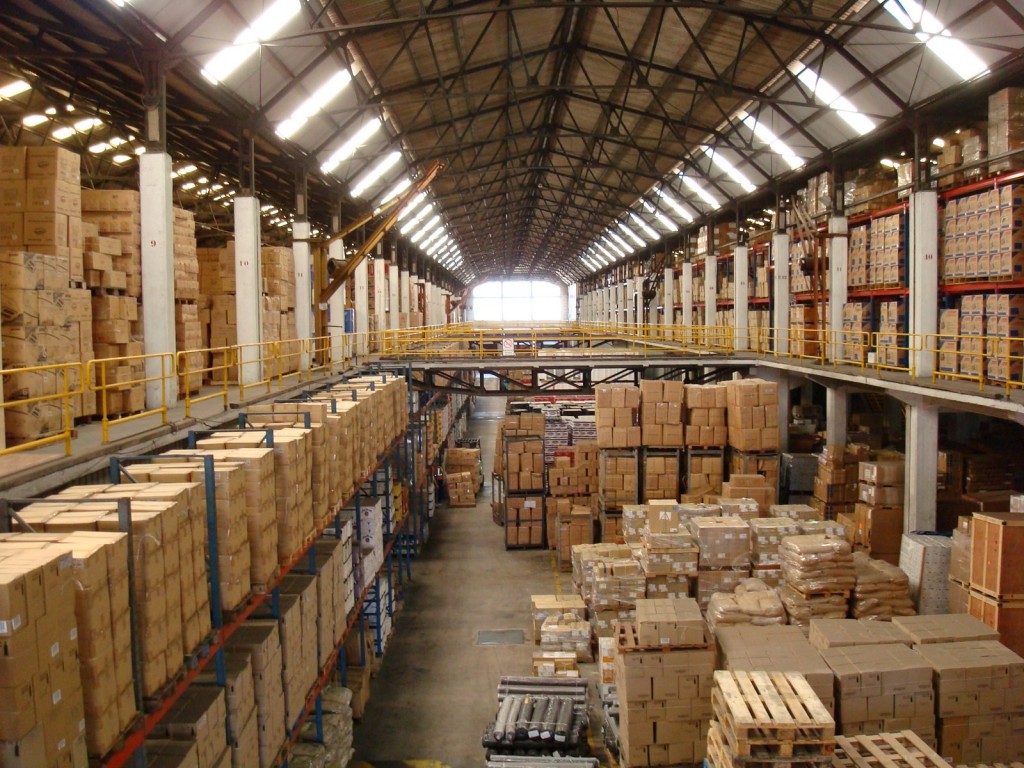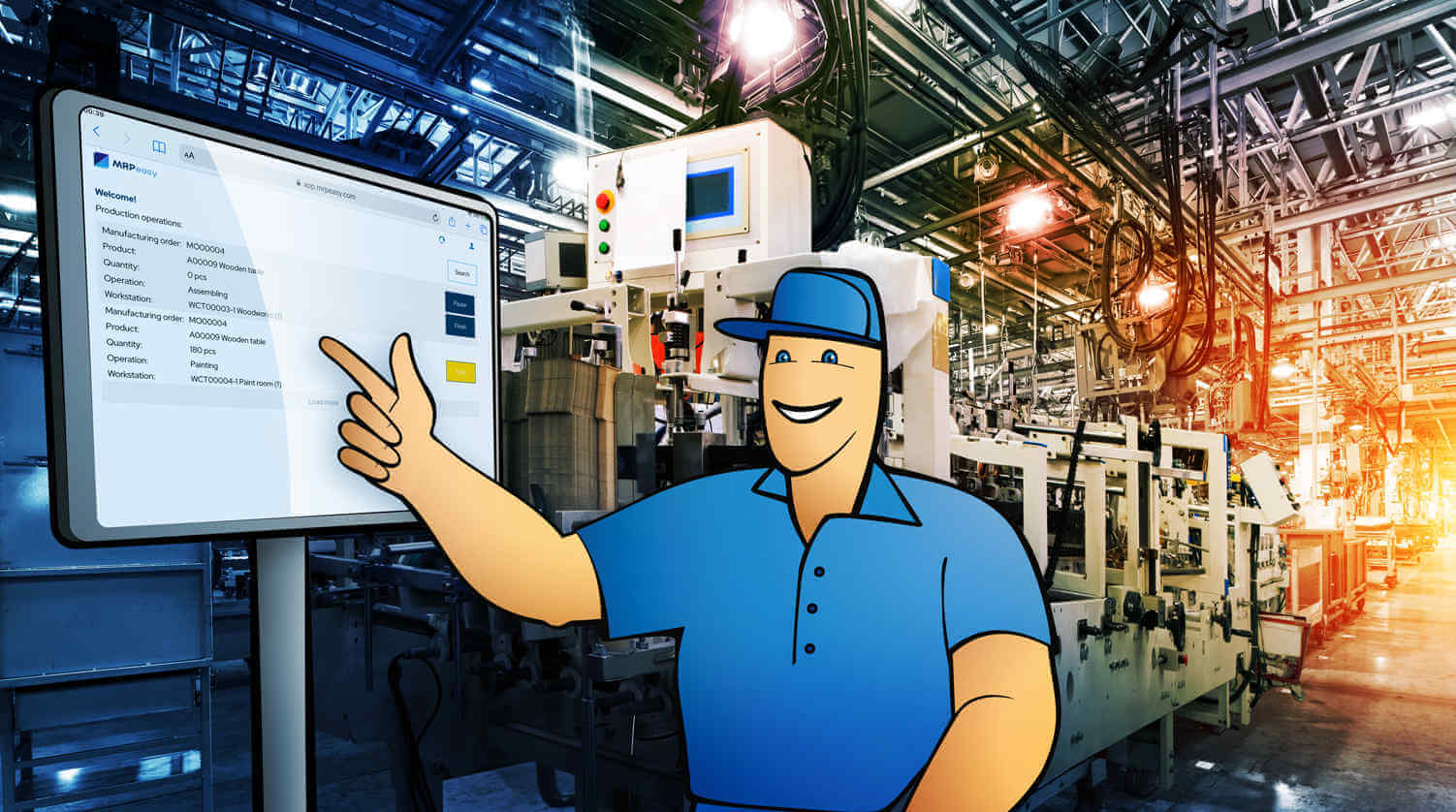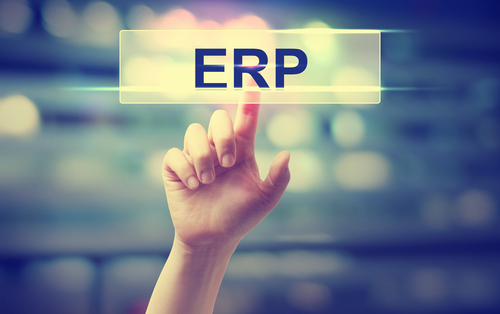ERP vs MRP – Picking the Right Manufacturing Software for SMEs
The right choice in manufacturing software can make the difference between effortless scaling and constant growing pains. In this article, we explore the key differences between MRP systems and ERPs and help you make an informed decision on which production management system to go for.

Why do SMEs need manufacturing software?
Manufacturing businesses and distributors often start small with only a handful of different products, simple inventories, and few vendors. Spreadsheets or paper-based production management solutions may at first seem like good options for handling easy workflows.
As companies grow in market traction and ambition, however, things will get more complicated. Sooner or later, basic productivity tools will reach their limits of accommodating this rise in complexity. This can be one of the biggest growing pains of scaling businesses as there’s suddenly much more paperwork and management headaches, inventory starts getting lost, and efficiency plummets. All of this can limit the budding growth.
Manufacturing software is designed to address this by automating and streamlining production processes, inventory management, procurement, and other business operations. What’s more, if implemented on day one, scalability can be built into the whole business operation from the very beginning.
Indeed, very simple operations can often make do with simple tools, relying on, for example, their chosen accounting platforms’ built-in stock management capacity. But for manufacturing companies and distributors with many types of goods and in-house manufacturing operations, cloud-based MRP systems or ERPs are the better option. Let’s explore these two solutions in a bit more detail.
What is an MRP system?
MRP systems are production software designed to manage, optimize, automate, and unify a company’s manufacturing process. The name comes from material requirements planning (also known as MRP I) – a term coined in the middle of the 20th century as the first computerized manufacturing systems were created. The role of these early MRPs was to provide production planning functionality by calculating the material requirements of jobs from planned production capacities and bills of materials (BOMs).
Modern MRPs, however, are based on a much more advanced version of this system – manufacturing resource planning (also known as MRP II). This software incorporates a suite of functionalities to enable managing all production and stock-related aspects of a business, from purchasing to quality control.
Functionalities of modern MRP-systems
- Production planning – scheduling and planning production activities through production capacity, demand forecasts, and material availability; BOM management, routing control, capacity planning, etc.
- Inventory management – tracking and reporting stock levels and movements, maintaining balanced stock levels to avoid stockouts and overstocking, built-in procurement and vendor management tools, materials management, warehouse management, etc.
- Order management – generating, managing, and tracking purchase orders, manufacturing orders, and customer orders; automatic cost calculation, etc.
- Shop floor management – shop floor control; limited manufacturing execution system; workstation and employee management; work and material consumption reporting, etc.
- Traceability – tracking stock items by serial number, batch, or stock lots; tracking jobs and work in process (WIP); automated reports, logs, and analytics.
With that, modern MRP systems can do a lot of heavy lifting on the production side of the business. Good providers also have integrations with third-party software solutions to enable extended functionality.
What is ERP software?
ERP or enterprise resource planning is comprehensive software intended to tie together all business processes of an organization. ERP systems provide a single platform that streamlines and unifies the data between relevant departments. While the concept of ERP emerged already in the 1960s and was developed in parallel with MRPs, the term was coined in the 1990s. These systems then gained popularity as companies sought more integrated approaches to managing their businesses.
ERPs extend beyond the manufacturing focus of MRP systems by offering a comprehensive suite of functionalities encompassing supply chain management, finances, human resources, customer relations, and more. Special manufacturing ERPs also incorporate strong manufacturing and stock management capabilities, by essentially integrating an MRP module into the software system.
With this, ERPs enable a more comprehensive view of operations and a broader scope of decision-making tools. This helps to further facilitate operational efficiency, better resource allocation, financial planning, etc.
Core functionalities of an ERP system
- Integrated business processes. A unified interface that links various departments like CRM, HR, finance, etc., enabling communication and data usage across the organization. Manufacturing ERPs also incorporate a full manufacturing ecosystem that enables managing the product’s lifecycle from sales and purchases to shipping and returns in a single interface.
- Real-time data analytics. Single source of truth and always-up-to-date data across all operations for improved decision-making; live metrics and automated reports.
- Financials. Financial control with features for cost accounting, budgeting, and financial risk management. Cash flow analysis, expense monitoring, etc.
Similarities and differences between MRP software and ERP
Choosing between MRP and ERP software can feel like navigating a maze. Both systems offer significant benefits for managing business operations. The core difference between these systems is pretty simple. MRPs are useful exclusively for companies that have inventories and add any kind of value to products (even if just packaging) within their supply chain. ERPs, on the other hand, can be suitable for a wide array of businesses, including but not limited to manufacturing and distribution operations.
Let’s break down the key aspects where MRPs and ERPs converge and diverge.
Similarities between MRP and ERP software
- Unified business processes. Both MRPs and ERP systems streamline operations by integrating various business processes. This helps in managing production more efficiently, from inventory to order fulfillment.
- Unified data management. At their core, both MRP and ERP systems centralize data management, allowing for a single source of truth that enhances decision-making and operational visibility.
- Cloud-based and SaaS options. The modern landscape of both MRP and ERP solutions is dominated by cloud-based and SaaS (Software as a Service) models, offering flexibility, scalability, and remote access to businesses of all sizes. However, on-premise solutions are also available for both software types.
- Inventory and production management. Both systems usually provide inventory management and production scheduling functionalities. In many ERPs, these are limited in scope compared to dedicated MRP software. However, manufacturing ERPs stand out by offering powerful capabilities alongside broader business management tools within a single platform.
- Analytics and reporting. With advanced analytics and reporting capabilities, both MRP systems and ERPs offer insights into operational performance, aiding in strategic decision-making to forecast demand, manage materials, and schedule activities.
Differences between MRP and ERP software
- Scope of functionality. MRP systems focus primarily on the manufacturing process and inventory management. ERP software covers a broader range of business functions, including HR, CRM, and financial management.
- Pricing and implementation complexity. Generally, ERP systems are more comprehensive, often coming with a higher price tag and a broader scope of implementation. MRP solutions, in turn, are more limited in scope, making them more affordable and somewhat easier to implement.
- Level of detail. Due to typically incorporating more business functions like CRM or HR, ERPs often provide a deeper insight into operational data than MRP systems. This brings a higher level of detail regarding analytics and forecasting power.
- Integrations. Extensive integration capabilities with third-party apps and services are a hallmark of both MRPs and ERP systems. However, ERP solutions often provide a wider range of integrations across diverse business functions, reflecting their broader application scope.
Benefits of modern cloud-based manufacturing software
Modern cloud-based manufacturing software brings a wealth of benefits from eradicating data duplication to effortless scalability. Whether you’re leaning toward an MRP system or a full-fledged ERP, here are some of the key benefits these solutions can bring to a scaling business.
- Improved collaboration and communication. Through a centralized data system, manufacturing software enables better and faster communication between departments and employees. This enhances teamwork, speeds up communication, negates data duplication errors, etc., leading to more streamlined project management and increased productivity.
- Cost savings. Despite its price and implementation costs, well-implemented manufacturing software leads to significant cost savings over time. This software is intended to improve process efficiencies, reduce manufacturing waste, spot areas of improvement, and make fine-tuned decisions based on real-time data. All this contributes to an optimized business operation that can significantly reduce its operational costs.
- Traceability and operational visibility. Manufacturing software significantly enhances traceability across the entire production lifecycle and supply chain. It offers businesses a detailed view of their operations from raw materials and work in process through to final product delivery and returns. With real-time data flowing through the whole system, businesses can easily track production processes, order statuses, inventory levels, and supplier performance. This helps companies maintain quality, ensure compliance, pinpoint bottlenecks, and boost efficiency.
- Scalability and customization. One of the most significant advantages of cloud-based manufacturing software lies in its scalability. Capable providers offer solutions that grow with your business, offering flexible solutions that can easily adapt to changing needs. This adaptability ensures that the manufacturing processes remain efficient and effective as the business evolves.
- Improved competitiveness. Traditional stand-alone on-premise manufacturing software used to be expensive and required extensive updating and IT infrastructure. This favored large manufacturers as SMEs often couldn’t afford the system or had no in-house IT. Cloud-based SaaS and modular ERP/MRP software levels the playing field, allowing SMEs access to the same features and functionality as their larger competitors at a cost-effective price.
Choosing the right tool
Deciding between an MRP system and an ERP solution hinges on various factors including company size, business needs, scaling ambitions, the level of desired integration, available resources for implementation, and budget. Here’s a breakdown of these considerations:
- Business size and scaling ambitions. Small businesses or those at the beginning stages of scaling might find an MRP system’s focus on production and inventory control sufficient. However, as the business grows and operations become more complex, the broader functionalities of an ERP including finance, HR, and CRM, might become necessary.
- Desired level of integration. If you’re looking to integrate various departments and operations into a single system, an ERP offers a more comprehensive solution. It’s particularly beneficial if you’re aiming for extensive data sharing and collaboration across different business units.
- Implementation resources: ERPs generally require a more significant investment in terms of time and resources for implementation compared to MRPs. Consider whether your business can afford the upfront cost and the temporary disruption during the transition.
- Affordability: While ERP systems offer more functionalities, they often come with a higher price tag. Assess whether the additional features justify the cost based on your business’s specific needs.
For small and scaling manufacturers and distributors, a manufacturing ERP solution often represents the best of both worlds, merging the focused capabilities of an MRP with the extensive functionalities of an ERP.
Purpose-built for small and scaling businesses, MRPeasy is a user-friendly yet capable manufacturing ERP system that effortlessly adapts to the needs of growing businesses. Setting up basic functionality is easy and advanced functionalities can be added as the use case evolves.
MRPeasy also stands out for its affordability. Being cloud-based, the software is always up-to-date and requires no additional infrastructure to maintain. It enables seamless integrations with financial, fulfillment, e-commerce, and many other apps. On top of a comprehensive stock and production management suite, MRPeasy includes a built-in standard accounting module, customer relationship management, and HR tools.
Key takeaways
- ERPs and MRP systems are business management software that have many similarities as well as distinctions. MRP systems are designed exclusively for manufacturing and distribution companies, while ERPs cater to a wider audience and can be suitable for a variety of different businesses.
- While its name comes from manufacturing resource planning, modern MRP systems are integrated production and inventory management software that are based on the manufacturing resource planning, or MRP II, methodology.
- ERP stands for enterprise resource planning. It is a comprehensive software suite that aims to integrate most or all of a company’s departments into a unified whole.
- Both MRPs and ERPs unify data management and business processes, have capable inventory and production management functionalities, and include built-in analytics and report generation.
- The chief difference between ERPs and MRPs lies in their business scope – MRPs are purpose-built for production and inventory management, while ERPs include more modules that incorporate sales, supply chain planning, HRM, and financials.
- For scaling manufacturers and distributors, hybrid manufacturing ERP solutions represent the best of both worlds. These solutions combine ease-of-use and affordability with robust productivity features and flexibility.
Frequently asked questions
ERPs differ from MRP systems in that they have a broader business scope. They incorporate more core business functionalities aside from production and inventory management, including customer relations management and sales, human resource management, and financials.
MRP stands for material requirements planning which is a production management methodology developed in the 1960s. Modern MRP systems use a more advanced version of this system, sharing the acronym MRP –manufacturing resource planning.
An MRP system is production management software designed to manage, optimize, schedule, and automate large parts of the manufacturing process. It integrates capacity planning, demand forecasting, inventory control, shop floor control, production scheduling, and other crucial manufacturing functionalities into a coherent system.
You might also like: Manufacturing Automation: Benefits, Tips, and Budget-Smart Options




